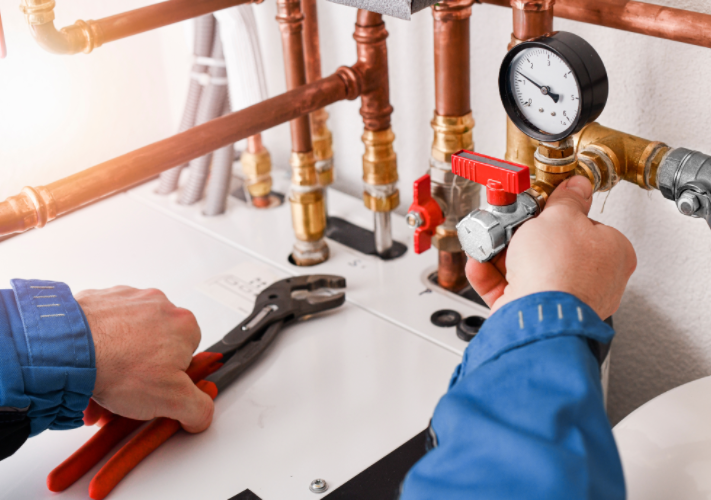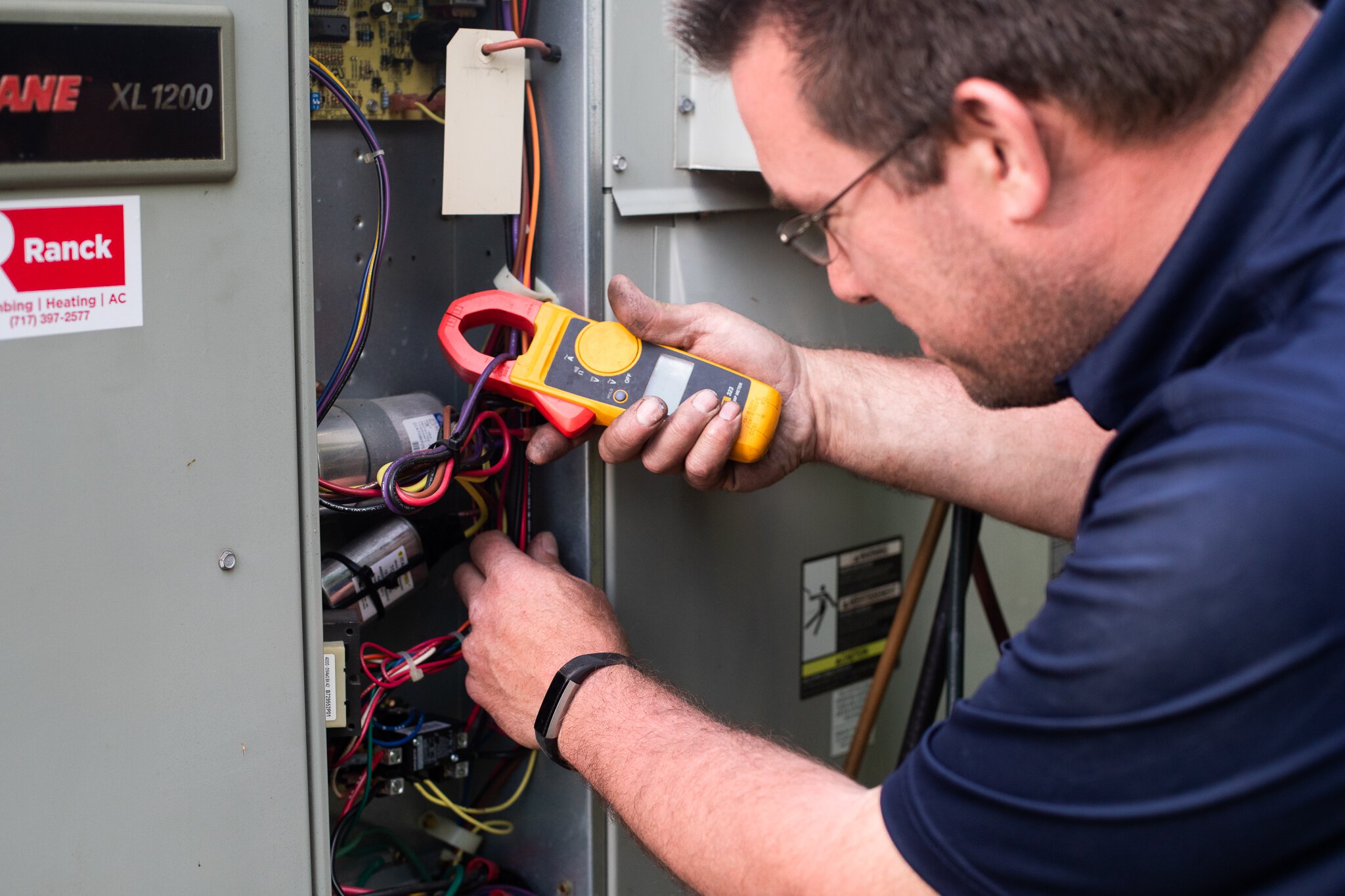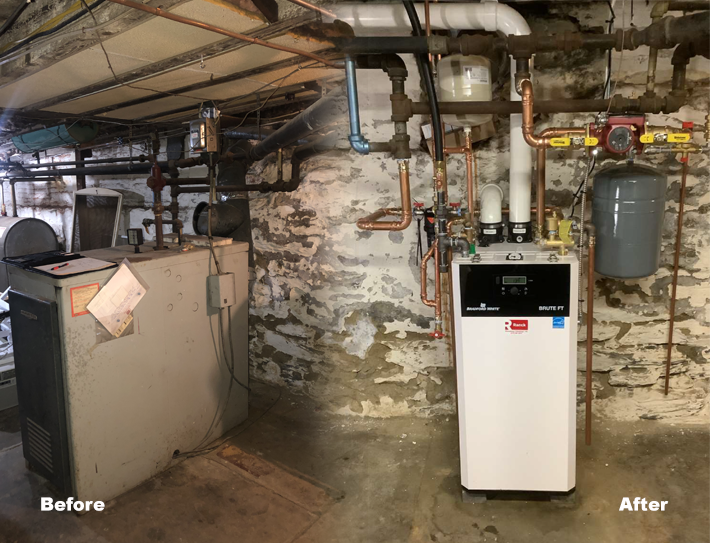
Expert Heating Services
In the winter, you don’t want to live in a cold house. Having a working heater is crucial to your family’s comfort.
Ranck offers quality service, maintenance, and heating installation to keep you and your family comfortable. Our heating service experts can help you find the perfect system for your home that won’t break your budget.

Need Emergency Heating Services?
When your heating system malfunctions, it can quickly become a stressful situation and you need a heating company you can trust. With 24-hour emergency HVAC repair, you can rest easy knowing that whenever there’s a problem, Ranck will be there to help.

Professional Heating Installation
In need of a new or replacement heating system? Let Ranck’s certified professional heating installation team guide you to a solution that will provide you and your family with a comfortable home environment.
Your journey will start with our expert sales team who will come to your home to assess your needs for comfort and provide you with a free quote and a few options that you can choose from that’s right for you and your home.
Ranck’s heating installation technicians are certified Mitsubishi Electric Cooling and Heating Diamond Contractors, as well as with Bosch® and Rheem® heating systems and units—in addition to having 70+ years of experience in the heating industry!
Learn more about our heating installation services today! Let’s find the best solution for your home.
Common Heating Problems & Solutions
Q. There are 2 settings for the fan on my thermostat: “automatic” and “on.” Which setting should I use?
A. The two positions are usually found if you have a central air cleaning system. The “automatic” setting means the fan’s cycle will be controlled by the temperature in the room.
However, if your home is equipped with an air cleaner or you wish to keep a continuous flow of air, switch the setting to “on.” Central air cleaning devices only work when the furnace is circulating air, so if you wish to get the most from your air cleaner, you should keep the setting to “on”.
Q. Should I have my furnace cleaned and maintained every year?
A. This is a good idea for several reasons. A cleaning means that your furnace will operate more efficiently, and thus, cost-effectively. The cleaning also includes a thorough safety check of the entire unit for cracked, defective, or damaged parts; if your parts are damaged, carbon monoxide could leak into your home without you even knowing it.
Why not sign up for our Preventive Maintenance Program? You’ll not only save money over regular service calls, but you can have peace of mind knowing that your furnace is being properly maintained. We will even handle the yearly reminder for you.
Q. If I go away for a long period during the winter, what temperature should I set my thermostat to?
A. We recommend 55 degrees. It’s low enough to save you energy and money but warm enough to protect your pipes and other vital parts of your home. On average, it will take 1 hour per degree to reach your desired temperature once you return.
Q. How can I even out the heating and cooling in my home?
A. You can adjust the registers on the wall or floor in the room where too much heat/cooling is present so that the registers are partially closed. For example, to get more heat upstairs during the winter, partially or fully close the registers downstairs to force more airflow to the registers upstairs.
Another possible solution is a furnace equipped with a variable-speed blower motor. These furnaces are designed to overcome airflow problems in a home, thus keeping the airflow steady throughout the entire house. These types of furnaces can also save considerable amounts of money in operating costs.
Q. How often should I change the standard filter on my furnace?
A. You should change your standard furnace filter every 6-8 weeks. Use your own judgment as to when to change it, but don’t let the filter get clogged, as this can cut down on the efficiency and/or cause damage to the unit.
Q. How efficient is my standard filter in removing dirt and pollutants from the air?
A. Standard 1″ throw-away furnace filters are between 5-10% particle efficient. This means these filters will only trap about 5-10% of what passes through them. You can improve the efficiency of the filtration of your heating and/or cooling system by upgrading to either a media or electronic-style filter.
A media-style filter’s particle removal efficiency is 60-65%, while an electronic-style filter is 90-95%. By upgrading to either of these, you will also cut down on maintenance costs on the system since dirty systems are the #1 cause of malfunction.
Q. How can I make sure that my HVAC unit is safe to operate?
A. Have your system checked annually for tiny cracks or perforations caused by the heat exchange. If you don’t, and your furnace is burning inefficiently or incompletely, carbon monoxide can escape and fill the house, causing serious health problems, and potentially death, to occupants of the home.
Q. What is a two-stage furnace?
A. A two-stage furnace operates on two stages: low and high, which have preset BTU outputs. On most days, the furnace will operate at the low stage to only provide the heat you need to stay comfortable. On very cold days, however, this furnace will use the high stage and give the full BTU output of the furnace to produce more heat for the home.
Check Out Our Recent Heating Blogs
-
4 Common Fall HVAC Problems
As the days shorten and the temperature drops, you may wonder when it’s time to switch your air conditioning off and switch to the heating system. Before you fire up […]
-
The Importance of Preventive Maintenance on Your HVAC System
Preventive maintenance is crucial if you have an HVAC system at your home. You rely on your heating and air conditioning systems all year-round, particularly during hot and cold months, making routine maintenance essential.
-
Maximizing Boiler Efficiency
Whether you want to lower your operating expenses or increase water heating performance, maintaining your boiler can help. Ranck Plumbing, Heating & Air Conditioning is here to help you maximize […]
Speak to Our Heating Experts Today
Looking for a heating technician for your home?
Contact our team to create a plan for your heating services.
This site is protected by reCAPTCHA and the Google Privacy Policy and Terms of Service apply.